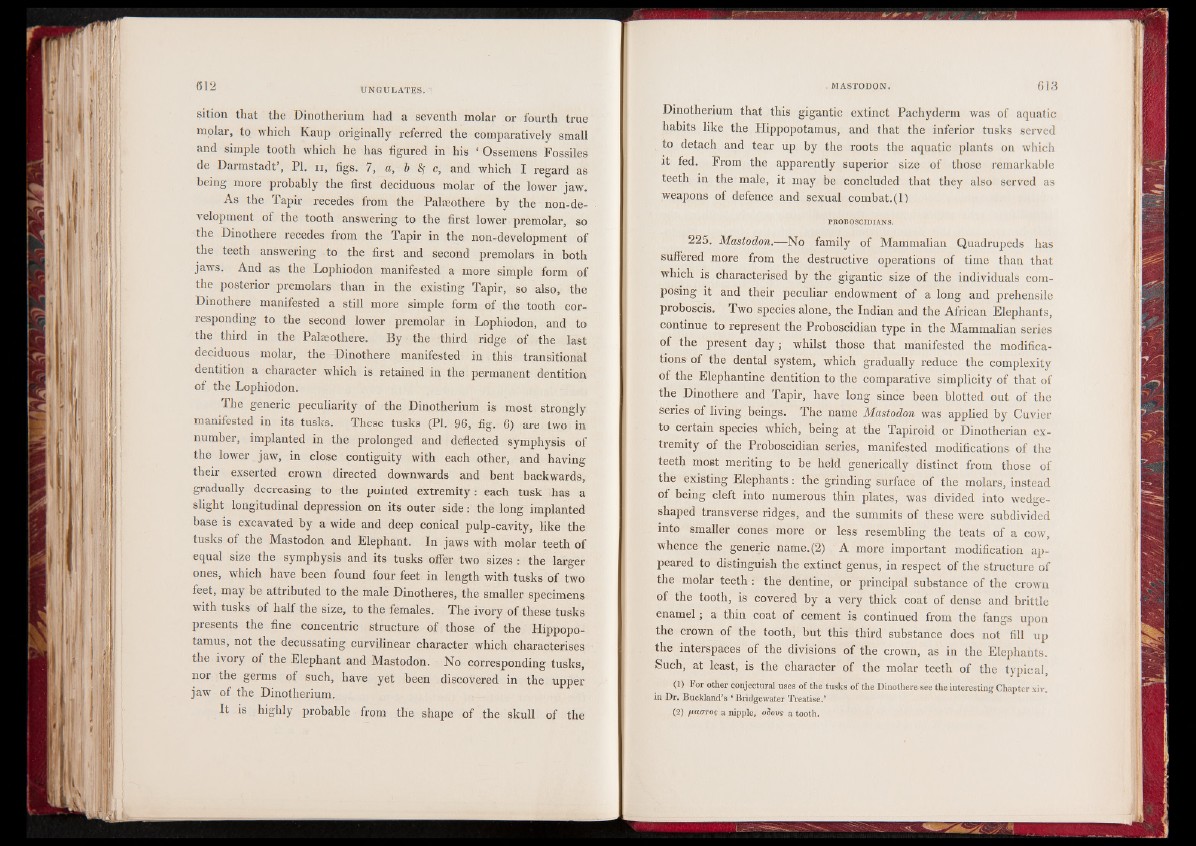
sition that the Dinotherium had a seventh molar or fourth true
molar, to which Kaup originally referred the comparatively small
and simple tooth which he has figured in his ‘ Ossemens Fossiles
de Darmstadt’, PI. n, figs. 7, a, b fy c, and which I regard as
being more probably the first deciduous molar of the lower jaw.
As the Tapir recedes from the Palseothere by the non-development
of the tooth answering to the first lower premolar, so
the Dinothere recedes from the Tapir in the non-development of
the teeth answering to the first and second premolars in both
jaws. And as the Lophiodon manifested a more simple form of
the posterior premolars than in the existing Tapir, so also, the
Dinothere manifested a still more simple form of the tooth corresponding
to the second lower premolar in Lophiodon, and to
the third in the Palseothere. By the third ridge of the last
deciduous molar, the Dinothere manifested in this transitional
dentition a character which is retained in the permanent dentition
of the Lophiodon.
The generic peculiarity of the Dinotherium is most strongly
manifested in its tusks. These tusks (PI. 96, fig. 6) are two in
number, implanted in the prolonged and deflected symphysis of
the lower jaw, in close contiguity with each other, and having
their exserted crown directed downwards and bent backwards,
gradually decreasing to the pointed extremity: each tusk has a
slight longitudinal depression on its outer side: the long implanted
base is excavated by a wide and deep conical pulp-cavity, like the
tusks of the Mastodon and Elephant. In jaws with molar teeth of
equal size the symphysis and its tusks offer two sizes : the larger
ones, which have been found four feet in length with tusks of two
feet, may be attributed to the male Dinotheres, the smaller specimens
with tusks of half the size, to the females. The ivory of these tusks
presents the fine concentric structure of those of the Hippopotamus,
not the decussating curvilinear character which characterises
the ivory of the Elephant and Mastodon. No corresponding tusks,
nor the germs of such, have yet been discovered in the upper
jaw of the Dinotherium.
It is highly probable from the shape of the skull of the
Dinotherium that this gigantic extinct Pachyderm was of aquatic
habits like the Hippopotamus, and that the inferior tusks served
to detach and tear up by the roots the aquatic plants on which
it fed. From the apparently superior size of those remarkable
teeth in the male, it may be concluded that they also served as
weapons of defence and sexual combat. (11
PROBOSCIDIANS.
225. Mastodon.—No family of Mammalian Quadrupeds has
suffered more from the destructive operations of time than that
which is characterised by the gigantic size of the individuals composing
it and their peculiar endowment of a long and prehensile
proboscis. Two species alone, the Indian and the African Elephants,
continue to represent the Proboscidian type in the Mammalian series
of the present day ; whilst those that manifested the modifications
of the dental system, which gradually reduce the complexity
of the Elephantine dentition to the comparative simplicity of that of
the Dinothere and Tapir, have long since been blotted out of the
series of living beings. The name Mastodon was applied by Cuvier
to certain species which, being at the Tapiroid or Dinotherian extremity
of the Proboscidian series, manifested modifications of the
teeth most meriting to be held generically distinct from those of
the existing Elephants : the grinding surface of the molars, instead
of being cleft into numerous thin plates, was divided into wedge-
shaped transverse ridges, and the summits of these were subdivided
into smaller cones more or less resembling the teats of a cow,
whence the generic name. (2) A more important modification appeared
to distinguish the extinct genus, in respect of the structure of
the molar teeth : the dentine, or principal substance of the crown
of the tooth, is covered by a very thick coat of dense and brittle
enamel ; a thin coat of cement is continued from the fangs upon
the crown of the tooth, hut this third substance does not fill up
the interspaces of the divisions of the crown, as in the Elephants.
Such, at least, is the character of the molar teeth of the typical,
(1) For other qonjectural uses of the tusks of the Dinothere see the interesting Chapter xiv.
in Dr. Buckland’s ‘ Bridgewater Treatise.5
(2) fMKTTOç a nipple, odovs a tooth.